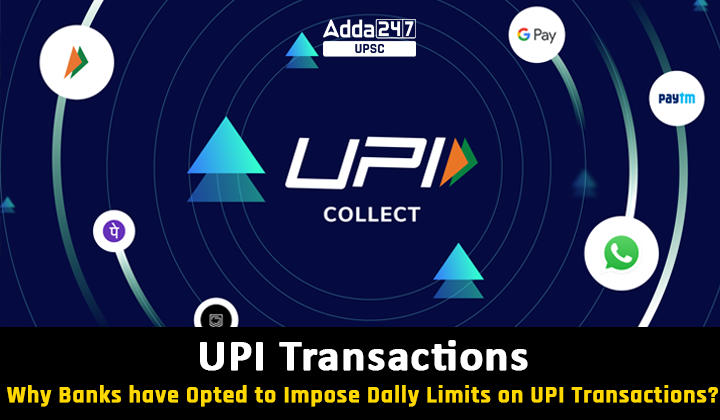Table of Contents
Limits on UPI Transactions: UPI is a real-time payment system developed by the National Payments Corporation of India (NPCI). UPI allows users to instantly transfer funds between bank accounts through a mobile platform. Limits on UPI Transactions topic is also important for UPSC Prelims Exam and UPSC Mains Exam (GS Paper 3- Indian Economy and Various Policy Measures in the banking sector of India).
Limits on UPI Transactions in News
With the Unified Payments Interface (UPI) witnessing an unprecedented surge in transactions, banks have implemented daily limits. These limits are in addition to the existing caps set by the National Payments Corporation of India (NPCI) in 2021. The objective behind this measure is to ensure the seamless operation of the payments interface while it continues to gain widespread popularity.
Daily Limits for UPI Transactions
Currently, users have the flexibility to conduct up to 20 transactions or ₹1 lakh in a single day, which can be done either collectively or spread out over the course of the day. However, specific categories of transactions such as capital markets, collections (including bills), insurance, and forward inward remittances have a higher limit of ₹2 lakh. In December 2021, the limit for UPI-based ASBA (Application Supported by Blocked Amount) IPO and retail direct schemes was raised to ₹5 lakh per transaction.
Proposed Limits for UPI Transactions
Banks and mobile applications are now establishing their own transaction guidelines. For instance, Punjab National Bank (PNB) and Bank of Baroda, both state-run lenders, have implemented a relatively lower transaction limit of ₹25,000. PNB has set its daily limit at ₹50,000. In the case of mobile apps, including Google Pay, users surpass the daily limit if they attempt to send money more than ten times in a single day across all UPI apps.
Industry’s Perspective on Limits for UPI Transactions
According to a spokesperson from PhonePe, the limits on transactions are established by considering both customer convenience and potential fraud or risk factors.
- The National Payments Corporation of India (NPCI) has also raised the value limits for specific categories with higher average transaction values, such as Capital Markets or Credit Card Bill payments.
- In terms of future growth and impact, the spokesperson mentioned that all participants in the ecosystem, including the NPCI and the regulator, regularly assess and adjust transaction and value limits on UPI as needed.
- This includes the implementation of higher limits for activities like IPOs, broking, mutual funds, and loan repayment.
Recent Trends Observed with Respect to UPI
By May of this year, the total count of transactions conducted through UPI rose to 9,415.19 million, with a combined value of approximately ₹14.89 lakh crore.
- An intriguing aspect lies in the breakdown between peer-to-peer (P2P) and peer-to-merchant (P2M) transactions. P2P transactions constituted around 43% of the total volume, amounting to 4,045.48 million transactions.
- However, in terms of value, P2P transactions accounted for a significantly higher share, reaching ₹11.45 lakh crore.
- In the P2P category, the majority of transactions fell within the below ₹500 range, accounting for 54.2% of the total.
- On the other hand, in the P2M category, a substantial 84.3% of transactions were in the same amount bracket. This highlights the relatively lower-value nature of P2M transactions.
- It’s worth noting that due to the diverse range of merchants and businesses, the transaction categorization may lean in favor of one side over the other, depending on the specific context.
Need for limiting UPI Transactions
It is worth highlighting that up until February of the financial year 2022-23, the total reported UPI fraud cases had increased by approximately 13% compared to the previous year, amounting to 95,402 cases. However, it is important to note that during the same period, there was a decline in the fraud to sales ratio, which stood at 0.0015%. Considering these factors, it becomes crucial to establish robust security infrastructure within the expanding UPI ecosystem in order to effectively combat the growing incidents of fraud.
Significance of Daily Limits for UPI Transactions
As the payments interface aims to broaden its reach, including the inclusion of non-resident accounts with international numbers, and as its relevance in everyday life increases, transaction limits play a crucial role in ensuring the security infrastructure and smooth operation of the system. These limits are especially important as the interface explores new use-cases, such as the proposed pilot project for coin-vending machines utilizing UPI as the facilitator.
Unified Payments Interface (UPI)
UPI stands for Unified Payments Interface. It is a real-time payment system developed by the National Payments Corporation of India (NPCI). UPI allows users to instantly transfer funds between bank accounts through a mobile platform. It enables seamless, secure, and convenient peer-to-peer (P2P) and peer-to-merchant (P2M) transactions using smartphones. UPI has gained widespread popularity in India and has revolutionized digital payments by offering a single interface for various banking services and payment options. Users can link their bank accounts to UPI and make transactions by simply using a unique virtual payment address (VPA) or scanning QR codes. UPI has significantly contributed to the growth of digital payments and the shift towards a cashless economy in India.
NPCI New Rules for UPI, NPCI Circular on Prepaid Payment Instruments (PPIs)
| Follow US |
| UPSC Govt Jobs UPSC Current Affairs UPSC Judiciary PCS Download Adda 247 App here to get the latest updates |



 TSPSC Group 1 Question Paper 2024, Downl...
TSPSC Group 1 Question Paper 2024, Downl...
 TSPSC Group 1 Answer key 2024 Out, Downl...
TSPSC Group 1 Answer key 2024 Out, Downl...
 UPSC Prelims 2024 Question Paper, Downlo...
UPSC Prelims 2024 Question Paper, Downlo...




